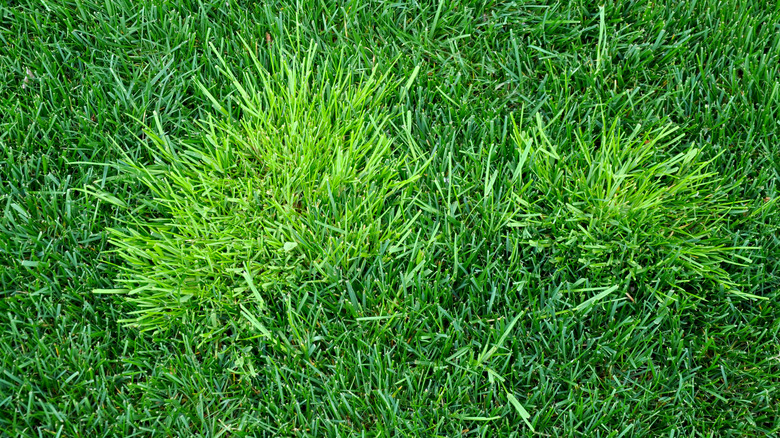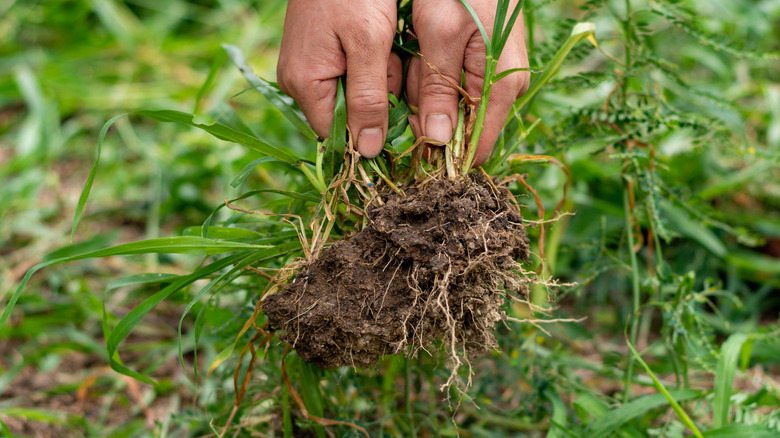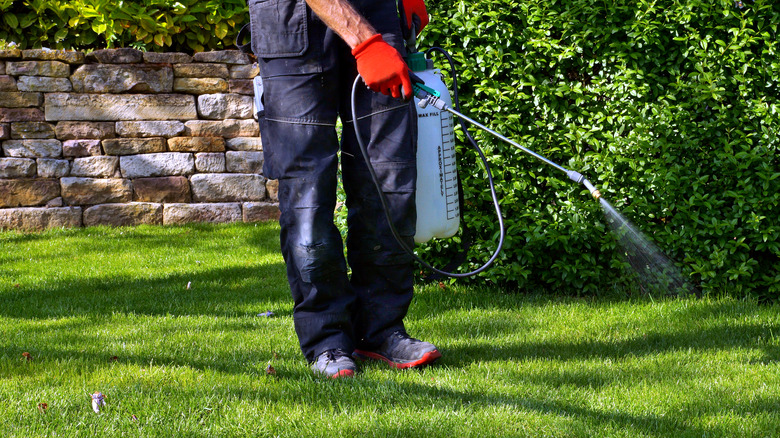What To Do About Winter Weeds In Your Lawn?
When the air grows cool and crisp, you may think your days of pulling weeds and maintaining a lawn are behind you, but winter weeds shouldn't be ignored. These weeds — which typically include annual bluegrass, deadnettle, and chickweed, among others — are annuals or perennials that spring to life in the late summer and early fall months. They tend to be slow growers that you may not notice at first, but it's important to take care of them now. This includes supporting healthy grass growth, utilizing a pre-emergent herbicide to fight them off, and using mulch as a treatment.
Manually pulling these weeds is desirable, and to do that, you'll need to identify them. Annual bluegrass (Poa annua) has curved-up leaf tips, making them look like a canoe, and features pale green growth in the spring. Deadnettle (Lamium purpureum) has pinkish flowers with triangular leaves and a squared stem. Chickweed (Stellaria media), which is often hiding in shaded areas, is a creeping plant, one with white flowers that have starred petals.
Most of these winter weeds shouldn't be ignored because they can be aggressive spreaders, not only creating significant growth themselves but also robbing the soil of nutrients your lawn needs to grow and thrive. With specific methods to get rid of weeds in your garden, it's possible to manage them before winter so that they don't flourish in the spring, making lawn care more difficult.
Manual removal of winter weeds is the first step
Once you discover winter weeds in your lawn, manually removing them is advisable in most situations. That's possible to do if the weeds have a shallow root system (such as those that creep along the ground) or those not in compact, hard soil that makes removal difficult. The key to remember here is that if you decide to dig up and pull the weed, you need to remove all of it, including all of the roots, to fully control the spread. At the same time, you have to be very careful about this because disturbing the seeds allows these weeds to spread rapidly from one area to the next.
To remove weeds, use a gloved hand to grab at the very base of the stem and pull upward firmly but gently, trying not to shake the plant too much. You can also use a weed removal tool or spade to help with this process. Contain the weed at that point by placing it into a container or bag to remove it from the area. Avoid carrying it any distance, as that allows the seeds to fall off.
Avoid a lot of digging or tilling of these areas of your lawn where weeds are present. Doing so only loosens the seeds more, allowing them to easily fall to the ground and start growing. Remove all evidence of weeds possible in the late fall or winter months, and repeat in the spring if needed.
Prevention is always the better option
Winter weeds are hard to control because of how easily they grow, but there are several steps you can take to control their presence in your yard throughout the year. Herbicides are one of the most effective options available for winter weed control, especially when applied in the early spring months prior to the weeds germinating.
One of the most effective options is a chemical-based herbicide that contains triclopyr, MCPP, or 2,4-D,which are going to help with broadleaf weed removal specifically. If these weeds are growing in your lawn rather than a flowerbed, use a product that's not likely to target your grass. You can also use natural herbicides, including those that include citric acid, essential oils, and sodium chloride combinations. You can use some DIY natural weed killers for this type of product. The most effective tend to include vinegar as a component of the treatment along with mild dish soap.
Finally, invest in pre-emergent herbicides, which are applied to the soil directly before any weeds begin to develop. Use these before the winter weeds start to sprout in the late summer months (apply them in early fall at the latest to avoid the onset of winter weeds). Look for pre-emergent herbicides designed specifically for broadleaf weed control in your lawn for the best overall results.


